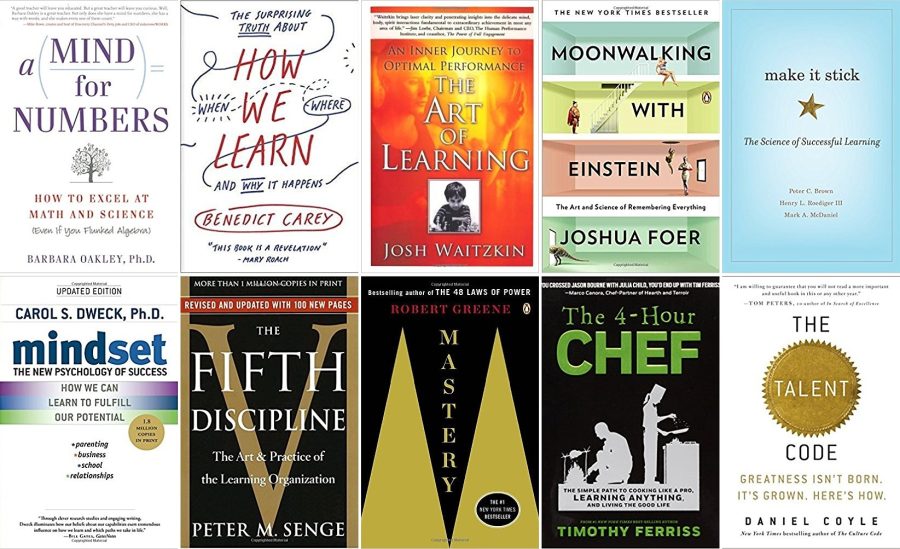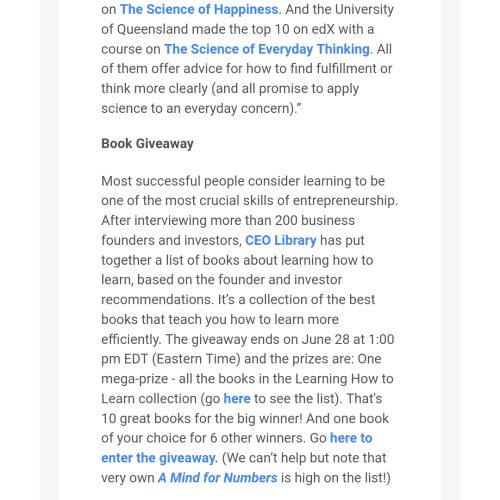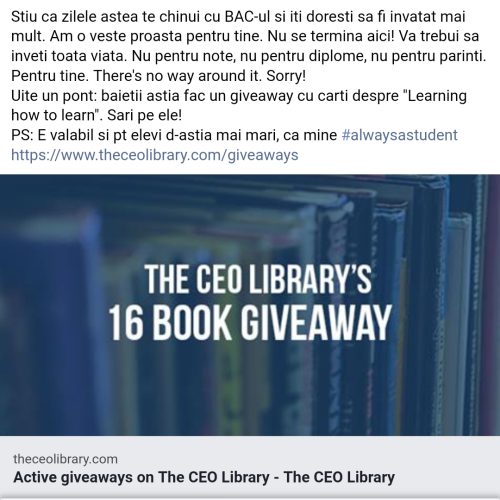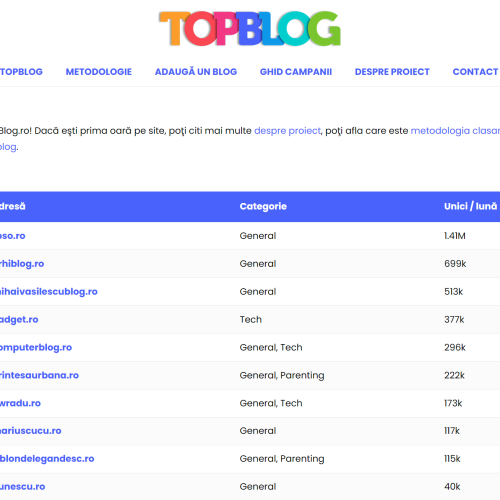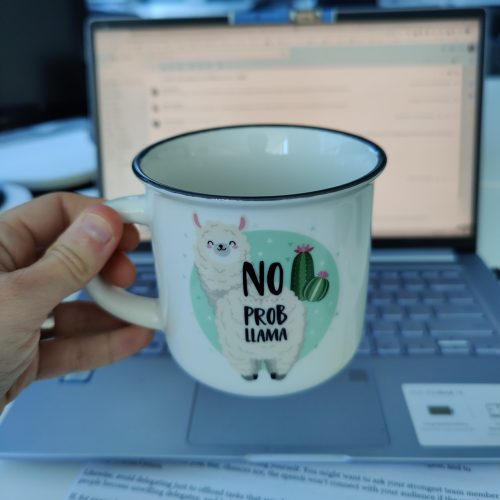I wrote this article in July 2018 and forgot to hit publish. Perhaps it’s still useful to anyone reading it. (no edits made to my 2018 version, I just added photos to that draft).
***
Here’s the anatomy of The CEO Library books giveaway that led to growing our mailing list from 712 to 3,058 subscribers (quadrupling it) in less than four weeks, with readers that are highly relevant for our long term goals, all while spending no money to promote this campaign – other than what we paid for the prize itself and the shipping. I included all the numbers, the fuck-ups, everything that had a high return or might have been was a waste of time, including lessons for future giveaways. If you have any questions, please address them publicly in the sections comment at the end, so that anyone else can see my reply.
Context:
In case you’re not familiar with The CEO Library: well, hello, nice to meet you! It’s a website with books recommended by successful entrepreneurs, for aspiring entrepreneurs, that I co-founded almost a year ago together with an old friend.
I’ve never before received so many extraordinary reactions and praises for a project. And still, it was stuck in a fragile state, growing at a way too slow of a pace. In order to be sustainable, I needed it to grow more, much more, and I needed it to happen fast.
Now here’s the problem. After 10 year experience in promoting others (hip-hop artists, mostly, but also all sorts of startups), I still feel bad at marketing and always wonder how I ended up in this field. I’m an introvert, always cautious not to be bothering anyone else. I’m a big fan of healthy, organic growth, and allergic to any kind of marketing technique that I feel might be slightly manipulative.
Just to prove my point, you should know that the first project that I started (called monden.info, now rebranded as Urban.ro) couldn’t be discovered through Google. We blocked the Google bot on purpose, to prevent it from appearing as a result on searches. It still grew into 10,000 visitors per day and 2,000 comments – which was a lot, for Romania circa 2010.
Campaign idea:
We started from this principle: focus on what doesn’t change. This is a lesson from Jeff Bezos, who said that no Amazon customer will ever say „I want this delivered in a longer time” or „I want this to cost more„.
How we applied that principle? Well, there are a few meta-skills that any entrepreneur needs to master – this was true in the ’70s and it’s true today as well. Skills such as the ability to learn quickly, to be comfortable with the uncertainty and risks, adapt easily to new situations, make decisions fast and never look back to regret them (only to draw lessons and see if the hypothesis were true), break bad habits and replace them with healthier ones, and so on.
Instead of focusing on biographies or books about business, marketing, sales and so on, as most websites for entrepreneurs do, we’re focusing on just a few evergreen subjects (Shane’s talk with Naval Ravikant was an inspiration as well – Naval talks about this kind of skills that we don’t learn in schools, although we need them.)
I started by making a list of the best 10 books on the subject of learning and mastery – Learning how to learn – all of them either read personally by me, or by the entrepreneurs I know and trust – those I’ve had the chance to interview in the past year.
Instead of just listing the books, I also added a personal and extremely long introduction. Based on my own experience about changing domains and starting from scratch, I explained why it’s so important for aspiring entrepreneurs to master the art of learning.
The campaign consisted in a basic giveaway, conditioned by the need to subscribe to The CEO Library newsletter. We gave away $300 worth of books – a total of 7 winners, the luckiest one got a pack with all the books in the “Learning how to learn” list, and six more winners who also got one book for free – any book of their choice and in whatever format they prefered.
Timeline:
Thursday, June 07 2018: 714 subscribers.
This was the day when I announced the collection of books about learning to our mailing list, and I also dropped a mention about the giveaway that was just about to start. I only mentioned the giveaway at the end, in the last 3 paragraphs – out of a total of 18 – so it was a pretty long email and perhaps not everyone noticed the announcement.
On Friday I also announced the giveaway in my own personal newsletter, the Friday Read – again, the odds are not everyone noticed it. It was just a paragraph out of a 2,000+ words long email. It had a 67% open rate, but only 68 people clicked on the link to the learning collection of books.
Tuesday, June 12 2018: 720 subscribers.
My colleague Vlad officially launched and announced our giveaway on this day, with a subject line that said: ‘Announcing The CEO Library’s first giveaway! Get $300 worth of books for free‘ .
So no more excuses here. If someone was subscribed to our newsletter, it was impossible for them to not find out about the giveaway straight from the subject we used.
Saturday, June 16 2018: 818 subscribers.
On the first week of the giveaway I was mostly on the road, travelling from the mountains to the seaside for two personal events that were important to me, but not work-related. It was a disruption in my usual routine and I didn’t have much time to spend online. I felt stuck in the purgatory: couldn’t keep up with my work, as I had planned initially, couldn’t enjoy 100% what was going on around me, and couldn’t sleep either.
So I missed the first week of the giveaway and, besides a few social media shares, I didn’t get to do any promo around this.
However, I did put a lot of time into creating a highly valuable weekly newsletter. In that weekend I read Daniel Pink’s new book ‘When’ and sent an email with lessons learned from it, about how entrepreneurs can use breaks to enhance their decision making capability.
Monday, June 25 2018: 2,404 subscribers.
So how did we jump from 800 subscribers to almost 2,500 in just one week?
Coming back from my trip, I did a couple of things:
1. I started by writing a long post for the Indie Hackers community, sharing my thought process behind the giveaway, the current status (real numbers included) and future goals. This step didn’t have a high outcome (only 4 votes and 19 visits to our giveaway), but I don’t regret it for a second.
I’ve been lurking on IndieHackers for a year or so, reading from the shadows what others write, but only this spring I started to be visible and get actively involved in the community. That’s because I’m not the type to enter a conversation unless I’m confident I have something valuable to add. There are two main reasons why I wanted to share the giveaway with the community over there: first of all, our readers and values overlap. I love Indie Hackers and I’m highly grateful that I had the chance to learn from makers and entrepreneurs who are bootstrapping their business while sharing their insights along the way in a highly transparent way. So it’s quality over quantity. Second of all, leaving asides the fact that those books about learning might really prove to be helpful to the community, I saw it as a way to give back to the community – bonus points for my karma. ![]() I knew others can learn from my thought process and apply to their projects as well. My post ended up retweeted by Indie Hackers (thanks!).
I knew others can learn from my thought process and apply to their projects as well. My post ended up retweeted by Indie Hackers (thanks!).
2. I wrote an article on my personal blog, describing the thought process behind this giveaway. I explained why I usually dislike giveaways and what I tried to do differently with this one. No more numbers this time, only a focus on my lessons from my past business experience and why I want to grow a mailing list for this project. King Sumo, the tool we used to create this giveaway, retweeted my blog post (thanks, guys!).
3. The most important step: I reached out to some of the authors of the books we were giving away. I started with those I personally read and enjoyed:
a) Josh Waitzkin: Josh’s book is first on the list of books about learning, and that’s only because I loved it so much. However, I knew that Josh is completely off the grid with social media, so instead I reached out to the president of his learning foundation – thank you, Katy! and also sent her a photo of me and Josh’s book.
b) Tim Ferriss: I reached out to his assistant, Donna, sent two emails, including a photo of me and Tim’s books, but never got a reply back. Considering that I’m personally receiving tens of emails per day and I can’t keep up with them, and I’m nobody, I’m guessing that Tim gets probably thousands of emails, so I wanted to try, but didn’t have high hopes of hearing back.
c) Carol Dweck, the author of Mindset – the last book on the learning list, since it’s not directly about learning, but about adopting the right growth mindset. I had just read her book and posted about it on The CEO Library channels and in my personal newsletter as well, so it was fresh in my mind, but Dr. Carol never got back to me.
d) Barbara Oakley: I only recently discovered her work – better later than never, I guess? Thanks to her episode in The Knowledge Project – one of my favorite podcasts, created by Shane Parrish (Farnam Street Blog), that I listened to and relistened in May. I also signed up to her online course Learning how to Learn that’s free on Coursera – and also the most taken online course, with over 1 million students.
Just to be clear, these were highly personalized emails, every one of them written from scratch, with no copy-paste. This means that I probably missed a few typos, but I also included:
– A paragraph where I mentioned how I discovered their books and how helpful I found them.
– Photos of me and their books – as I said, I personally read them and was influenced by them.
– Specific requests from each of them. Ex: I’m subscribed to Barbara’s Friday newsletter that’s being sent to the students of her learning course and includes valuable resources related to learning, so I asked if there’s any way our giveaway might be mentioned there.
From these four, only two of them replied, but it was enough. Barbara included us in the Cheery Friday newsletter, that’s sent out to Coursera students of the Learning how to Learn course on Coursera – the most popular online course.
We jumped overnight from 800 to almost 2,500 subscribers, which caused me to panic. I didn’t get any sleep during that weekend. My colleague Vlad was unavailable, without any phone signal and I wasn’t able to reach him, so I just kept my eyes on the traffic and crossed my fingers that we have no tech issues.
I spent most of my Sunday working on the next email that I sent on Monday morning – once again, I wanted it to be highly valuable, so that subscribers don’t lose trust in us once the giveaway is over and they don’t unsubscribe. The main topic was when to quit and when to stick, and I started from Kanye West’s story and what we can learn from him about resilience, moved on to my own experience with people calling me crazy, touched the subject of the shiny object syndrome among entrepreneurs, what Yaro Starak was talking about in our interview, and ended with four books that I read on the subject and might prove to be helpful.
Monday, July 02 2018: 3,058 subscribers.
Last mile. I reached out to two friends and asked them to help me out with the giveaway.
One of them is Deliric – an old friend that I highly admire and I’ve had always had a lot to learn from him. „Deliric” is actually his stage name – he’s a rapper, the most streamed Romanian artist on Spotify, and co-founder of the most popular Romanian streetwear brand, called PORC. I knew he has a huge community of teens following him and, since the Bacalaureat just started (the Romanian high school graduation exams), I figured this is an excellent opportunity for him to share our giveaway with books about learning. Deliric wrote a Facebook post announcing high school students that learning doesn’t end with that exam and they’ll be learning for the rest of their lives. But no pressure, haha. While the visible reactions where nowhere close to the kind of things he usually shares on social media, our number of subscribers had a 25% growth afterwards, jumping from 2,400 to 3,000.
The other friend is Alex, owner of a digital agency called Superior Media. Alex has a blog that’s followed especially by marketers and people working in advertising. That’s why I initially pitched him the angle of sharing my blog post about the giveaway, where I talked about the strategy behind it, as I thought it would be the most interesting version for his audience. Alex wrote a thorough article with a title that incites curiosity, rough translation: „When was the last time you spent $300 on books?”. He included more information about the giveaway, why he highly recommends our newsletter, and he also announced my article published in DoR (popular Romanian magazine) about quitting social media. Thank you for your support, Alex!
Marius Vasilescu, another popular Romanian blogger, read Alex’s blog post and wrote about our giveaway as well (thanks, Marius!).
Andra Zaharia, another good old friend of mine, also mentioned our giveaway 48 hours before it ended in ‘How do you know?‘, her weekly newsletter on decision making. Andra’s been constantly writing about what we do at The CEO Library, so I can’t thank her enough for her help.
In the last 48 hours before the giveaway ended we also got featured on King Sumo’s Instagram account – the software we used for the giveaway. However, from the caption it wasn’t clear that the books are about learning and recommended by entrepreneurs, and it looked like we’re giving books for those who want to start their own business.
FUCKUPS
Major Fuckup:
Bad timing. Unfortunately, this giveaway overlapped a hard and disrupting phase for The CEO Library (are there ever any easy days for a startup?). There have been some major changes in the team – now it’s only me and Vlad, Theo’s out, Bobby‘s no longer involved in day-to-day activities, and both me and Vlad were on the road for most of this giveaway. For the first week I was in Sibiu, attending the theatre festival (FITS), while Vlad, who’s in charge of all of the technical aspects, left on the sea right when I got back (literally: he’s also working as a skipper), without phone signal or the possibility to easily get in touch with him.
More Fuckups:
Minor Fuckup #1: We’re using MailChimp to manage our mailing list and I stupidly forgot that we were using the free plan of the platform, that’s limited to 2,000 subscribers.
Minor Fuckup #2: My account to manage The CEO Library’s mailing lists was set up with Editor rights instead of Admin.
Minor Fuckup #3: I was stressed out and didn’t sleep properly, which only affected my cognitive abilities.
Ok, let me elaborate on that.
After Barbara Oakley shared our giveaway in her Friday newsletter, we had a huge spike, jumping from 800 to more than 2,000 subscribers overnight. MailChimp suspended our ongoing campaigns – I’m talking about those welcome emails that are being sent automatically to any new subscribers and they’re important to introduce people to what we’re doing. We’re also offering them some important content, such as a yearly reading plan for entrepreneurs and Machiavelli’s The Prince – for free.
Well, all these emails stopped being sent to new subscribers midnight between Friday and Saturday. While I was on the lookout that night and couldn’t sleep, afraid that something will go wrong with the giveaway and I’m all alone on the technical front, I still had no idea why MailChimp stopped sending those emails.
I was refreshing MailChimp’s stats, I did notice the message that the ongoing campaigns were currently paused, but it didn’t say WHY exactly. Because I was tired, it took me a while to figure out why. What’s even more stupid, at first I thought they were paused because of the high volume and that perhaps they’re sending them into batches. Only Saturday afternoon I figured out what happened. I went to the Account settings and there was a message saying that we need to upgrade the account in order to send more emails.
One last bump to overcome: my account only had Editor rights, not Admin, so I couldn’t add a credit card and just pay to upgrade it. Vlad was unreachable, but I got in touch with Bobby, who was driving across Ireland – it took a few more hours until he was able to make me an Admin, I finally upgraded the account and the mails started to roll again to new subscribers’ inboxes.
Even more Fuckups:
There were tens of more things that I could have done to promote this giveaway – most of them pre-planned in advance, but I didn’t have any energy or time left to actually do them.
A few examples of things I didn’t do:
– I didn’t get to reach out to all the other authors of the books I gave away (only contacted 4 out of 10).
– I didn’t get to send a follow-up email to Dr. Carol Dweck.
– Except for Vladimir Oane, I didn’t get to announce the entrepreneurs who recommended those books that we were giving away and ask them to share the giveaway.
– I made a list of entrepreneurs and bloggers that I follow and I knew they previously wrote on the topic (learning how to learn), but didn’t get to contact them either.
– Same with those who reviewed or summarized the books we mentioned in our giveaway.
– Send an extra & dedicated newsletter to remind people about our giveaway.
– Do a video where I film myself talking about this giveaway and upload it everywhere.
– Speaking of uploading everywhere, I didn’t post as much on social media. This is part of my battle with wasting time there – it’s draining my energy and damaging my mental health.
– I didn’t announce it on Reddit. I’m too scared of their active users.
Ok, I’m gonna stop here, not to get too depressed about my mistakes.
WHAT’S NEXT?
Yesterday we extracted the winners using KingSumo and reached out to all of them via email, six out of seven already replied and sent me the information I requested regarding where to ship the books they won. So the next step is actually sending the prizes. I also asked them how they’re going to use the prize, if they have any particular purpose at this moment, any skill that they’re interested in – that’s because at The CEO Library we always encourage reading with a purpose, not just for leisure or general education.
Going to continue focusing on the newsletter, deliver highly valuable content through it, so that those folks that joined us for this giveaway won’t leave any time soon. Obviously, I’m going to unsubscribe all those who don’t open our emails for several weeks in a row – something that I’ve been doing for my personal newsletter as well, in order to make sure that the open rates and deliverability remain high.
No more giveaways any time soon. This is not a long term strategy and, if abused, it won’t have a positive effect. My next big project consists in writing a book related to one of those specific skills dedicated to entrepreneurs: how to use social media as a tool and don’t let it disrupt you.
RECAP
To sum it up, here’s what you should keep in mind from everything I wrote here:
1. Try to do something different from what everyone else is doing, but also provide quality content and remain aligned with your own values.
2. Always keep your target in mind and go after relevant communities. Quality over quantity.
3. Cold emailing works – if you do it right. That means writing personal emails, drafted individually, where you also specify why you reach out to them and how they can help. No copy-paste, no bullshit, no out-of-the-line request. Yes, it will take you a lot of time and energy, but it’s worth it.
4. Don’t forget to leverage your network – but, of course, only when it’s something valuable for their communities. And never abuse them.
5. Without providing something valuable, promoting something is not enough or sustainable over the long-term – you might be catching people’s attention today, but you’ll lose it tomorrow and it will all fall down like a castle of sand.
6. Keep in mind the 80/20 principle: 80% of the outcome will always come from 20% of actions. (Obviously, this is just a benchmark, probably not the exact proportion, and you can’t know exactly beforehand what are the 20% of actions that will bring the most results. I strongly encourage you to read Richard Koch’s book for more details about this principle.)
Hope you found this useful or at least interesting.
